|
|
|
| My Favourite Planet > English > Europe > Greece > Macedonia > Pella |
| Pella, Greece |
A brief history of Pella |
 |
page 2 |
 |
|
| |

Mosaic of Dionysos riding a panther, from the "House of Dionysos". Pella Archaeological Museum. |
| |
"Pella, the greatest of the cities in Macedonia"
Xenophon, Hellenika, V, 2, 13
Pella is just a dream city. It started as a dream and returned to the dreamstate, to the stuff of myth and legend all too soon. How many other fabulous cities have suffered this fate one can only guess.
Unlike other great cities of the classical Greek world, such as Athens, Troy, Ephesus or Rhodes, Pella did not grow in importance or wealth over centuries due to strategic location, natural resources or the cunning of its inhabitants. It was planted there by one man, flowered rapidly within a few generations to become the capital of much of the known world, then faded and withered almost as quickly.
All that was left was the legend, the dream, until a local school teacher and amateur archaeologist, Athanasios Kondrouphis, stumbled upon its remains in 1953.
True, there had been a settlement here from time immemorial before the Macedonian King Archelaos I (Ἀρχέλαος Α΄, ruled 413-399 BC) moved his capital there from Aigai (today Vergina, see page 4) around the end of the 5th century BC. Neolithic settlers had been replaced by Cretans (allegedly), who in their turn had been ousted by Macedonian tribes from the north. |
| |
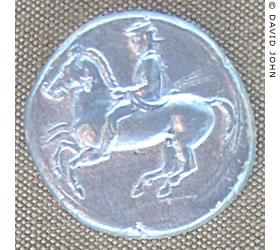
Silver didrachm of King Archelaos
of Macedon (ruled 413-399 BC).
Pella Archaeological Museum. |
|
| |
| |
The city's location was on the shore of a lake connected to or an inlet on the Thermaic Gulf (depending on which theory you believe) northwest of Thessaloniki. [1]
In moving his court from the hills to a port on the plain, Archelaos was bringing his kingdom within easier reach of the rest of Greece, much of which preferred not to think of their Macedonian cousins as Greek at all. If the Macedonians ever had an inferiority complex about this, they were about to overcome it big time.
Thanks to the breathtaking ambition of Archelaos, then Philip II and ultimately his son Alexander The Great, the Macedonians were not only grudgingly allowed into the Greek gang, they became the leaders in a series of moves that makes The Godfather look like kindergarten stuff. |
|
|
|
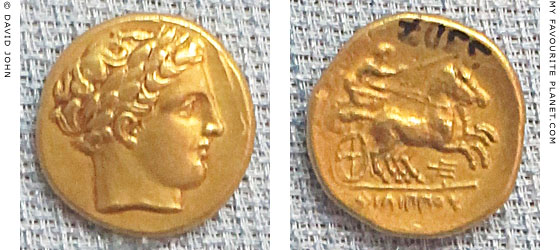
Gold staters of Philip II of Macedonia (ruled 359-336 BC), circa 323/2 - circa 315 BC.
Obverse: head of Apollo. Reverse: two-horse chariot over the name "ΦΙΛΙΠΠΟΥ" (Philip).
Izmir Museum of History and Art (Izmir Tarih ve Sanat Müzesi), Izmir, Turkey. |
| |
Early Macedonian humour
An anecdote concerning King Archelaos is said
to be the oldest joke recorded. It goes like this:
A talkative barber asked Archelaos how he wanted his hair cut.
"In silence!" was his pithy reply. [2]
Pella grew with Macedonia as a whole from what Athenians considered a barbarous backwater to being an unprecedented centre of power, commerce and culture. It became the glittering city of its time, with splendours said to rival Athens. Greek craftsmen and artists were imported to design and build it. Zeuxis the painter decorated the royal palace, Euripides the playwright, wrote and produced his last plays here (including The Bacchae), and the musican Timotheos of Miletus and the Athenian tragic poet Agathon also moved to the city.
The first author known to have mentioned Pella was the 5th century BC historian Herodotus (Histories, Book 7, chapter 123), although only as part of a list of cities in areas passed by the Persian fleet during Xerxes' invasion of Greece in 480 BC (see History of Ancient Stageira part 4). According to one ancient source, Herodotus may have lived in the Macedonian capital at the end of his life and been buried here, although this claim is not supported by other ancient authors. [3]
Later the philosopher Aristotle may have taught here, although he is thought to have tutored Alexander the Great and the sons of other nobles in his academy at Mieza, near Naousa [4]. Aristotle's father Nicomachos was a personal physician of King Amyntas III of Macedonia.
Of the extents or limits of Archelaos' dreams we know little, but his ability to gain and consolidate power, shift paradigms and think ahead evidently passed on to Philip II. They were more than just pragmatic warriors, they had vision and they were builders. Archelaos kept the Macedonians united as a proto-nation, held together by ties of blood, religion and mutual interest (what's in it for me and my 3000 favourite cousins?). Philip was able to build on this to extend his dominion, chiefly as a military strategist, to become the first unifier of Greece.
Alexander, in his turn, took on board all the painful lessons his forebears had learned and pushed them into warp drive. His dream was to conquer the world, and he did, or at least an enormous swathe of the known world from the eastern Mediterranean, through Anatolia and the Levant to Egypt, and as far east as northwest India. He created a Greek empire by destroying that of the Persians who had dominated the near east and central Asia for over 200 years.
He died intestate in Babylon in 323 BC. With no will, testament or named successor, his nearest and dearest (the "Diadochi", successors) quickly began murdering each other and grabbing as much of his newly-won empire as they could. That was the end, my friend. Greece fell apart again, and reverted to its ageless and endless ruinous feuds.
Whatever Alexander's dreams may have been for the future his hometown Pella, it rapidly diminished in significance during the carve-up ensuing his death. His mother, Olympia, was not above murdering the competition and their children. Needs must, or carry on the dream?
By the time the Romans moved in, it was relatively easy pickings. They conquered Pella in 168 BC, causing a lot of damage in the process. The city remained occupied for another century or so until it was destroyed by an earthquake.
Meanwhile the lake or inlet on which Pella stood, and to which it owed much of its prosperity, rapidly silted up, leaving it high and dry [see note 1]. So Pella was abandoned and forgotten for nearly 2000 years, except in dusty books, legends and of course dreams.
So what remains of the dream?
Travellers from northern European countries passed through the area in the 18th and 19th centuries, but the exact location of Pella remained uncertain: several scholars thought that the ancient city was at Edessa (then known by its Slavic name Vodena, it was also identified by some as the location of Aigai) or around the ruins known as the "Baths of Alexander", near Nea Pella.
During Byzantine times the village of Pella had become known as Agoi Apostoli (Άγιοι Απόστολοι, Holy Apostles), and in the Ottoman period it was also known by the Macedonian Slavic name Postol (Постол, Свети Апостол, Sveti Apostol, Holy Apostles) and to the Turks as Allah Kilise (God's Church).
Meanwhile, local people at Pella retained many traditions and legends of ancient Pella, and, as Greek archaeologist Photios Petsas was to discover when he arrived here in 1953, several safeguarded in their homes artefacts they had found in the fields. Athanasios Kondrouphis, who had diligently collected local historical information, proved to be a well-spring of knowledge for the professional archaeologists when they started the first systematic excavations here in 1957. [11]
There have been almost continuous excavations underway at the site since 1976, and still the extent of the city is unkown. It requires some imagination to mentally reconstruct how Pella must have looked during its heyday. If a few pillars, foundations and mosaic floors don't seem like much help, try the nearby Pella Museum for more inspiration. |
| |

A solid-hilted bronze
sword, said to be
from Pella [5].
17th - 16th century BC.
Neues Museum, Berlin.
Inv. No. Fr 1143. |
| |
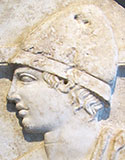
Soldier of Pella [6] |
| |
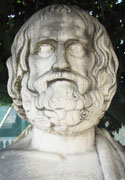
Euripides
Modern bust in front
of Pella town hall [7] |
| |
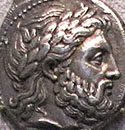
Philip II of Macedon [8] |
| |
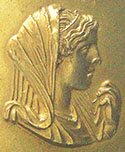
Olympias, Philip's wife,
Alexander's mother [9] |
| |
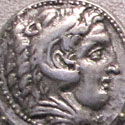
Alexander the Great [10] |
| |
| |
Pella
history |
Notes, references and links |
 |
|
1. Pella was abandoned because the river mouth on which it lay silted up. It was actually the mouth of several rivers which drained into the Thermaic Gulf, though not an estuary since the Mediterranean is not tidal. Many other ports such as Ephesus and Miletus in Anatolia have suffered a similar fate.
The silt carried to the sea by rivers is a natural phenomenon but also results from soil erosion caused by continuous farming. As today in other places in the world, early farmers around the Mediterranean cleared forests and other natural habitats to plant their crops which also used up a considerable amount of water. We also know that Macedonia was a major supplier of timber around the region (it supplied the needs of Athens' navy - "wooden walls" of Themistocles), and it is highly unlikely that they had an efficient sustainable forestry management policy.
Over centuries, millions of tons of exposed soil were blown away by the wind or washed away by rain, and much of it ended up being dumped in the sea. Since there was no tide to take it away and the ancients had no dredgers, the stuff just lay there and piled up. Much later, The Romans (notably Emperor Claudius) were to come up with ingenious and expensive (also in human casualties) engineering methods for clearing harbours, but that's another story.
There has been much work published on this subject, but one of the most interesting discussions I have found on the internet directly relating to Pella is on a website dedicated to fly fishing. No kidding.
"Astraes, the first fly fishing river", an academic paper by Goran Grubic and Andrew Herd, originally published in The American Fly Fisher, 2001. A very entertaining piece and a great source of information and maps for anybody interested in the history, geology and environment of the area, even if you are not a dedicated angler. Thanks guys.
Link: www.flyfishinghistory.com/contents.htm |
|
|
2. "Barbers indeed are generally a talkative race, for people fond of prating flock to them and sit in their shops, so that they pick up the habit from their customers. It was a witty answer therefore of King Archelaos, when a talkative barber put the towel round his neck, and asked him, 'How shall I shave you, O king?' 'Silently,' said the monarch."
Plutarch's Morals (Moralia; Greek, Ἠθικά), translated by Arthur Richard Shilleto. XV On talkativeness, § xiii, 122. Bohn's Classical Library, George Bell & Sons, London, 1898. At Project Gutenberg.
An illustration of the Tanagra figurine of a barber (image, right) was first published in:
Hugo Blümner, Terracotten aus Tanagra, pages 140-143 and Tafel 14, in Ernst Curtius und Richard Schöne, Archäologische Zeitung XXXII (Band 7, Jahrgang 32). Deutsches Archäologisches Institut. Georg Reimer, Berlin, 1875. At the Internet Archive.
The illustration was also published in: Oskar Seyffert, A dictionary of classical antiquities, mythology, religion and art (3rd edition in English), page 511. Swan Sonnenschein and Co., London, 1895. At the Internet Archive.
A similar figurine is in the Museum of Fine Arts, Boston.
Inv. No. 01.7784. See:
www.mfa.org/collections/object/barber-cutting-a-mans-hair-151729
3. Herodotus and Pella
"... he voluntarily went to Thurii which was being colonized by Athenians, and after he died there he was buried in the agora. But some say that he died in Pella."
The Suda, Ἡρόδοτος, eta,536. At Suda On Line.
For further details, see the Herodotus page in the MFP People section.
4. Read more about Aristotle and his birthplace Ancient Stageira in our Travel guide to Stageira and Olympiada. |
|
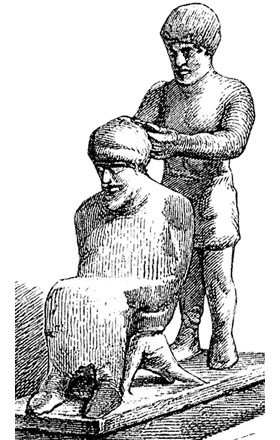
Terracotta figurine of a barber cutting
a man's hair, from Tanagra, Boeotia.
Early 5th century BC.
Source: Jakob von Falke, Hellas
und Rom, eine Culturgeschichte des
classischen Alterthums. W. Spemann,
Stuttgart, 1878. |
|
| |
5. The bronze sword, reported to have been found in Pella Greece, now in the Neues Museum, Berlin. Acquired in 1837 from the collection of Carl Wilhelm Becker (1772-1830), known as "Antiken-Becker".
Described by Bastian and Voss as being of the Apa type. Length of hilt 11.5 cm, length of blade 43.8 cm, maximum width (at hilt) 9.8 cm.
Becker was a renowned polymath who worked as a goldsmith, art and antiquities dealer, and was the librarian and a court advisor (Hofrat) to the imperial prince Carl Friedrich Ludwig Moritz von Isenburg-Birstein. His reputation was tarnished when it was discovered that he had forged many of the supposedly ancient coins he sold to wealthy customers. The veracity of information concerning the antiquities in Becker's collection has therefore also been doubted, and it has been suggest that the sword may have actually been found in the Rhine Valley, in the area of Frankfurt am Main, and near to where Becker lived. This theory is based on a record of a similar Bronze Age sword found near Frankfurt and said to be in the possession of a certain "Herr Carl Ant. Milani" of Frankfurt.
See:
Adolf Bastian (1826-1905) and Albert Franz Ludwig Voss (1837-1906), Die Bronzeschwerter des königlichen Museums zu Berlin, page 59 and Tafel XIII, Fig. 1. Wiedmannsche Büchhandlung, Berlin, 1878. At the Internet Archive.
John Evans (1823-1908), The ancient bronze implements, weapons, and ornaments, of Great Britain and Ireland, page 298. Longmans, Green and Co., London, 1881. At the Internet Archive.
Sir Richard Francis Burton (1821-1890), The Book of the sword, page 262. Chatto and Windus, London, 1884. At the Internet Archive.
Imma Kilian-Dirlmeier, Die Schwerter in Griechenland (außerhalb der Peloponnes), Bulgarien und Albanien, Nr. 444. Franz Steiner Verlag, Stuttgart, 1993.
The sword from the Rhine Valley decribed and illustrated (see drawing, right): Ludwig Lindenschmit (1809-1893), Alterthümer unserer heidnischen Vorzeit, Band III, Heft VIII, Tafel 1, Fig. 1. Römisch-Germanisches Centralmuseum Mainz. Druck und Verlag von Victor V. Zabern, Mainz, 1871. At Google Books. |
|

The similar Bronze Age
sword found near
Frankfurt am Main. |
|
| |
6. Detail of a marble funerary stele from Pella, with a relief of a soldier wearing a pilos helmet. Classical period, 430-420 BC.
Istanbul Archaeological Museum.
Inv. No. 85 T. Cat. Mendel 39.
See Pella gallery page 18.
7. Modern marble Portrait bust of the Athenian tragedian Euripides (Εὐριπίδης, circa 480-406 BC) in front of Pella town hall. The sculpture stands on a tall base, resembling that of an ancient herm, on which quotations about the playwright by the historian Thucydides are inscribed. The likeness is based on several ancient busts, mostly Roman copies of a Greek original of the 4th century BC, in museums around the world. See, for example Athens Acropolis gallery page 36.
Euripides wrote his final plays in Pella, including the now lost Archelaos, in praise of his host, and the Bacchae, which had its premiere here (or perhaps at Dion) around 408 BC.
He is said to have been killed by hunting dogs at Arethousa, Macedonia, where Archelaos built a tomb for him. According to the Roman architect Vitruvius:
"In Macedonia, at the place where Euripides is buried, two streams approach from the right and left of his tomb, and unite. By one of these, travellers are in the habit of lying down and taking luncheon, because its water is good; but nobody goes near the stream on the other side of the tomb, because its water is said to be death-dealing."
Vitruvius, Ten books on architecture, Book VIII, chapter 3. At Project Gutenberg.
The stream may be the Richios, the only outlet of Lake Bolbi, the site of Arethousa, near the village of Rentina (see History of Stageira and Olympiada part 8). |
|
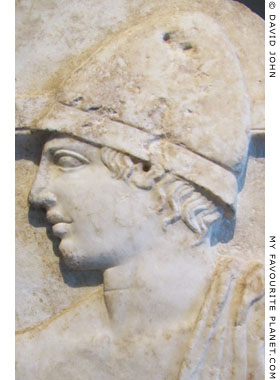
Funerary relief of a soldier, from Pella. |
|
 |
8. Macedonian silver tetradrachm coin bearing the portrait head of King Philip II of Macedon (Greek, Φίλιππος Β' ὁ Μακεδών, 382–336 BC, ruled 359-336 BC), father of Alexander the Great.

Macedonian
star-burst symbol. |
|
The reverse side of another Philip II tetradachm (photo, right) shows Philip on horseback, holding a palm branch and the word "Φίλιππου" (Philippou). The image celebrates the victory of his race horse in the Olympic Games in 356 BC, the year of Alexander's birth.
Below the horse is the star-burst symbol of Macedonia, which has become known as the "Vergina Sun", after its depiction on the "Golden Larnax", a funerary casket found in the Royal Tombs at Vergina, the ancient Macedonian capital Aigai (Αιγαί). Some scholars believe that the larnax may have contained the remains of Philip. This simplified star on this coin has only 8 points, whereas the modern flag of Macedonia has 16 (see top of page).
342/341 - 329/328 BC. Altes Museum, Berlin.
Photos: © David John
9. Olympias (Ὀλυμπιάς, circa 375-316 BC), Epirote princess, daughter of the Molossian king Neoptolemus I of Epirus (northwestern Greece), fourth wife of Philip II, mother of Alexander the Great. She married Philip in 357 BC.
In the photo above she is depicted on the obverse of a gold medallion struck in the mid 3rd century AD, found in Abukir, Egypt in 1902. The reverse side shows a Nereid, possibly Thetis, riding a sea monster. Thought to be a reference to Thetis as the mother of the Homeric hero Achilles, and thus associating the mythic figures with Olympias and her son. Olympias' family, the Aeacidae, claimed descent from Neoptolemus, son of Achilles.
These medallions were minted by Roman emperors as gifts for high-ranking officers and officials at the Alexandrian Olympic games, held in Macedonian cities such as Veria.
Thessaloniki Archaeological Museum.
The Bode Museum, Berlin also has several of these medallions, including one of Olympias, three types with different portraits of Alexander and one with a portrait of Emperor Caracalla.
Photo: © David John
Read about the Olympia's death and the legend of her banishment to Olympiada, near Aristotle's birthplace of Stageira, in History of Stageira and Olympiada - Part 6.
10. Silver tetradrachm coin from Pella, bearing the portrait head of King Alexander III of Macedon (Αλέξανδρος Γ' ο Μακεδών), better known as Alexander the Great (Ἀλέξανδρος ὁ Μέγας, Aléxandros o Mégas, 356-323 BC). Circa 325-315 BC.
Altes Museum, Berlin.
Photo: © David John
See more information and images of Alexander the Great
on gallery page 5.
11. The first trial excavations at Pella were directed by Georgios Oikonomos (Γεώργιος Π. Οικονόμος, 1883-1951) of the Greek Archaeological Service in 1912 and 1914-1915, shortly after the this part of Macedonia became independent from Ottoman Turkey. Nothing of significance was discovered and at the time the site was considered to be of little importance.
Oikonomos' report on his excations at Pella were published in: Πρακτικά της Αρχαιολογικής Εταιρείας, 1914 (1915). Η εν Αθήναις Αρχαιολογική Εταιρεία. (Praktika tēs en Athēnais Archaiologikēs Hetaireias 1914 (1915). Hē En Athēnais Archaiologikē Hetaireia), Athens, 1915. At Heidelberg University Library.
The first systematic excavations at Pella from 1957 to 1963 were led by Charalambos J. Makaronas (Xαράλαμπος Mακαρόνας, 1905-1977) and Photios Michael Petsas (Φώτιος Μ. Πέτσας, 1918-2004). In the first year they made several vital discoveries, including the "House of Dionysos" and its splendid mosaic floors which are now key exhibits of the new Pella Archaeological Museum. See Pella gallery page 2.
See:
Photios Petsas, Archaeology, 11 [1958], pages 246-254.
Photios Petsas, Ten years at Pella. Archaeology, Summer 1964, Volume 17, Number 2, pages 77-84. |
| |
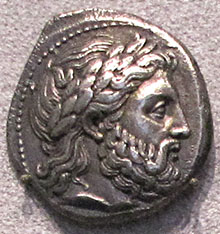
Philip II of Macedon tetradrachm.
Altes Museum, Berlin. |
| |
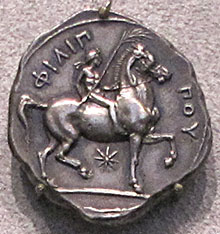
Reverse side of a Philip II
tetradrachm.
Altes Museum, Berlin. |
| |
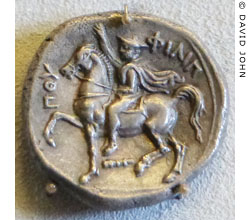
Tetradrachm of Philip II from
Amphipolis, Macedonia. 359-336 BC.
Bode Museum, Berlin. |
| |
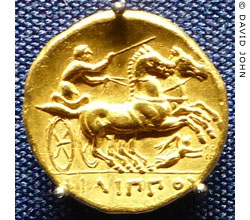
Gold stater of Philip II from Pella.
Similar to the coin in the Izmir
museum (see above), the reverse
side shows a two-horse chariot
over the name "ΦΙΛΙΠΠΟΥ" (Philip).
A winged Nike carrying a victor's
wreath flies below the horses.
Münzkabinett, Staatliche
Kunstsammlungen, Dresden. |
| |
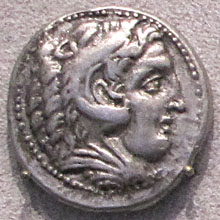
Tetradrachm coin of Alexander
the Great from Pella.
Altes Museum, Berlin. |
| |
Photos, maps and articles: copyright © David John,
except where otherwise specified.
Some of the information and photos in this guide to Pella
originally appeared in 2004 on davidjohnberlin.de.
All photos and articles are copyright protected.
Images and materials by other authors
have been attributed where applicable.
Please do not use these photos or articles without permission.
If you are interested in using any of the photos for your website,
project or publication, please get in contact.
Higher resolution versions are available on request.
My Favourite Planet makes great efforts to provide comprehensive and accurate information across this website. However, we can take no responsibility for inaccuracies or changes made by providers of services mentioned on these pages. |
|
| |
 |
Visit the My Favourite Planet Group on Facebook.
Join the group, write a message or comment,
post photos and videos, start a discussion... |
|
|
| |
|
|
|